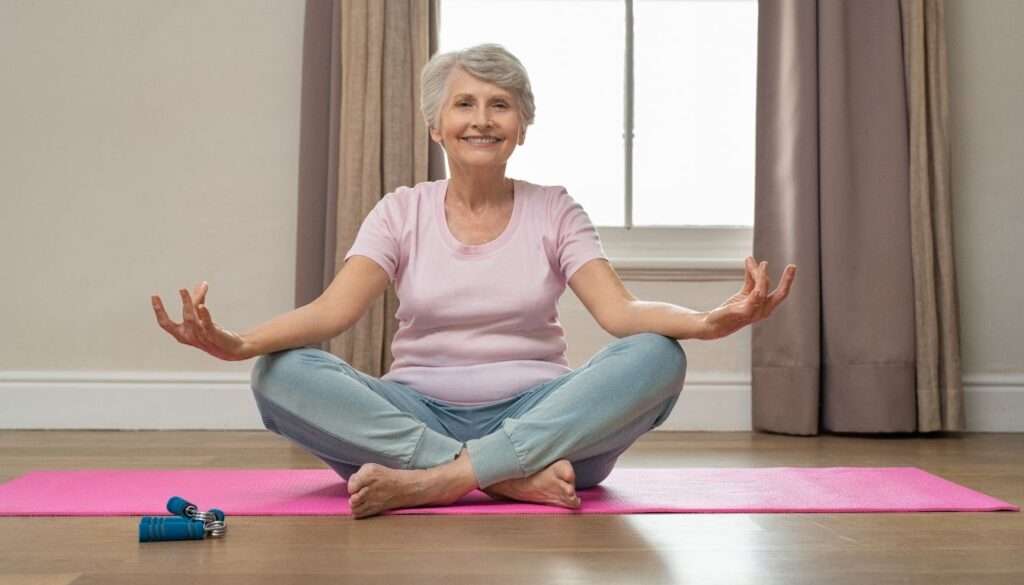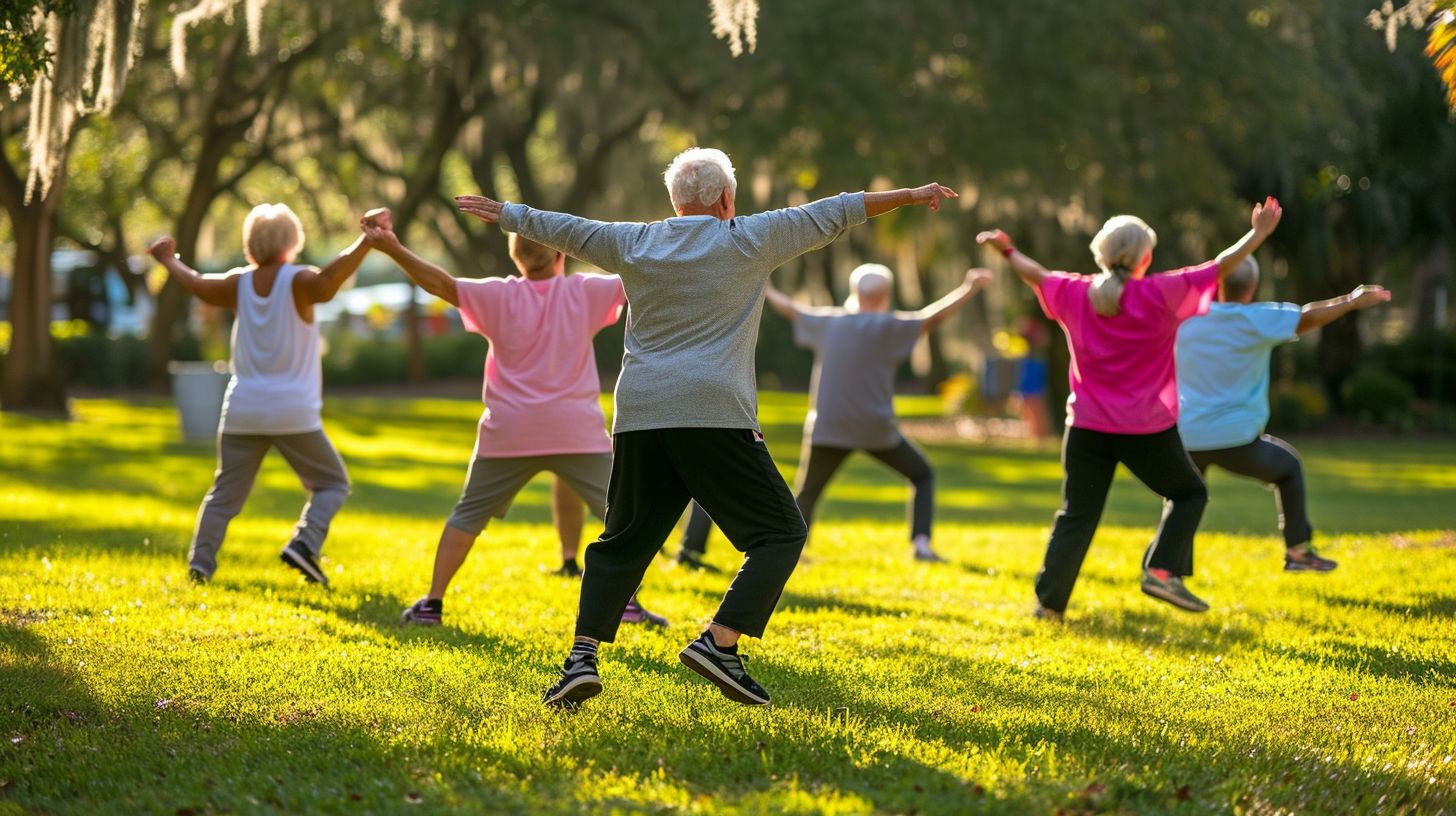As we age, maintaining balance and stability becomes a top priority for leading an active lifestyle. Did you know that one in four Americans aged 65+ falls each year? This article is your guiding light to stronger core muscles which are the cornerstone of good balance.
Delve into our list of the top 10 core exercises tailored for seniors that promise to enhance your stability with every move. Let’s get sturdy!
Key Takeaways
- Seniors should do core exercises 2-3 times a week to help with balance and daily life.
- Talking to a healthcare professional before starting new workouts is important, especially for those with medical conditions.
- Core strengthening can reduce pain, improve posture, and make everyday tasks easier for seniors.
- Exercises, like Seated Dead Bugs, Bridges, and Marching in Place, are among the top activities for older adults to build core stability.
- High-impact activities such as full sit-ups and heavy squats are risky for seniors and may lead to injuries. Stick with low-stress exercises instead.
Understanding the Core Muscles

The core muscles are your body’s foundation. They include your abdomen, back, and pelvis muscles. These muscles work together to help you stand straight, turn, and move without falling.
Think of them as a sturdy box that holds everything stable. This “box” has the rectus abdominis in front – that’s the muscle people often call the “six-pack.”.
On the sides are the obliques; they let you twist and bend side-to-side. Your lower back has muscles called erector spinae which keep your spine upright. Underneath lies the transverse abdominis; it wraps around like a belt for deep support.
The glutes or buttock muscles also play a key role in core strength, helping with movement from the hips down to your legs. Keeping these core muscles strong is like making sure a tree’s roots are deep so it stays standing tall and doesn’t tip over in strong winds.
Importance of Core Strengthening for Seniors

For seniors, core strengthening isn’t just another workout trend—it’s a critical component of overall health and independence. A strong core can transform how one navigates the golden years, from improved posture to fewer aches and pains, all while making daily activities feel effortless.
Enhancing Balance and Stability
Strong core muscles are key for good balance and staying steady on your feet. These muscles wrap around your belly and back, working together to help you stand upright without wobbling.
When you strengthen them with the right exercises, you make it easier to walk, turn, and even reach up high without losing your balance.
Think of core strengthening like training the anchor of a ship; it keeps everything stable in choppy waters. By practicing these important workouts regularly, seniors can lower their risk of falls and stay independent longer.
This means enjoying life more without worrying as much about getting hurt from a tumble.
Simplifying Daily Tasks
Core exercises for seniors make life easier. They help with getting up from a chair, carrying groceries, and opening jars. Imagine bending to tie your shoe without feeling tight or wobbly—that’s what a strong core does for you.
A fit core means less struggle with daily chores and more energy for fun stuff.
Regular core workouts let seniors lift objects without hurting their backs. These exercises give your body the strength it needs all day long. Strong abdominal muscles mean you can play with your grandkids or garden without fear of pain afterwards.
With practice, things like walking the dog or making the bed become smoother and safer too.
Promoting Better Posture
Good posture isn’t just about looking poised; it’s a cornerstone of your overall health. Strengthening your core is like giving your body a suit of armor against poor posture that can lead to back pain and balance issues.
Think of it this way – your core muscles are the support system keeping you upright, steady, and less prone to falls. They ensure your back is supported, maintaining the natural curves of your spine.
As you strengthen these muscles through targeted exercises, you’ll likely notice standing straighter becomes easier. Your shoulders will naturally roll back, and that hunched-over feeling when sitting or walking will start to fade away.
Stronger abs and back muscles take the strain off; they brace the spinal column for better alignment and function in everyday activities. It’s not just about avoiding slouches; it’s about building a more resilient frame that carries you confidently through life.
Reducing Pain
Better posture from core exercises can lead to less pain. Stronger muscles support your spine and take pressure off painful areas. Core strengthening is key for managing discomfort in the back and knees.
For seniors, this is especially important as it relates to osteoporosis and muscle loss.
Core workouts aren’t just about a flat stomach; they help with pain management too. By focusing on the rectus abdominis, transverse abdominis, and spinal erectors, you target what’s needed for relief.
Doing these exercises 15-20 minutes a day could mean saying goodbye to annoying aches that get in the way of life!
Improving Coordination
Strong core muscles help you keep your balance. Coordination means your movements are smooth and safe. Exercises, like seated dead bugs or marching in place, make it easier for you to move without falling.
Think about how a strong core lets you twist, reach across the table, or step off a curb without a wobble.
Your body relies on the core for most activities. Lifting groceries? That takes coordination from a robust midsection, too. Even simple things like getting out of bed become safer when your abdomen and back muscles work well together.
Practice these exercises regularly and watch how they improve your confidence in moving gracefully throughout the day.
Signs of a Weak Core

Spotting a weak core isn’t always straightforward—after all, it’s not just about those six-pack abs. It could be as subtle as feeling wobbly while standing or taking an extra moment to straighten up after sitting; these are your body’s whispers, hinting that your central support system might need a boost.
Lower Back Pain
Lower back pain is a signal that your core might need some attention. It’s common among seniors and can throw off your balance. Strengthening the muscles in your middle can ease back discomfort and make you steadier on your feet.
Focus on building a stronger core, and you may notice less pain when you walk, sit or stand.
Exercises for the abdominals, obliques, and lower back are key to improving this issue. They don’t just support your spine; they help with movements like twisting and lifting too. Make these exercises part of your routine to help keep lower back pain at bay.
Your body will thank you with each step you take without a wince!
Lack of Stability
Feeling unsteady on your feet is not just about slippery floors or wearing the wrong shoes. It’s often because your core muscles are not strong enough. Those muscles hold you up and keep you balanced.
If they’re weak, you might sway more or feel like you could fall while doing simple things like walking to the mailbox.
Strengthening these muscles helps a lot with balance. Core exercises can make your midsection solid and ready for actions like reaching high shelves or turning to back out of the driveway.
Improving stability means fewer falls and more confidence in moving around.
– Difficulty in Performing Everyday Tasks
Difficulty in Performing Everyday Tasks
Weak core muscles might make simple things hard for seniors. You could find it tough to bend down to pick something up or reach high shelves. Standing from a sitting position can feel like too much effort.
These struggles happen when the muscles around your belly, back, and hips aren’t strong enough.
With a stronger core, you’ll move with more ease and less pain. Tasks like carrying groceries, climbing stairs, or even playing with grandkids become smoother. A routine with core exercises turns these everyday activities into no big deal! It brings back strength to your midsection so that your body can support itself better in daily life.
Top 10 Core Exercises for Seniors

Discover our curated list of the top 10 core exercises designed specifically for seniors—each one focused on building a stronger, more stable core to empower your daily activities and reduce the risk of falls; keep reading to find out how these moves can transform your routine and enhance your overall well-being.
Seated Dead Bug
Try the Seated Dead Bug to get your core muscles working. Sit on a chair’s edge, keep your back straight, and engage those abs. Lift one leg up, straight out in front of you. At the same time, raise your opposite arm over your head.
This can be tricky at first because it tests your balance, but stick with it! Your abdominis muscles will thank you.
You’re not just sitting; you are strengthening too! Switch legs and arms each time to challenge both sides of your body equally. It doesn’t put stress on joints or bones, so it’s great for keeping fit without any pain.
Do this move as part of your weekly routine – it’s a safe bet for better core strength and stability.
Seated Side Bends
Seated side bends are a great move for seniors to work on their core, especially the oblique muscles. These muscles are key for stopping falls and making sure you keep your balance.
To do this exercise, sit up tall in a chair with your feet flat on the floor. Keep one hand down by your side and reach the other arm over your head, bending at the waist towards the opposite side.
It feels like reaching over to pick an apple from a tree!
Make sure to breathe out as you bend and inhale as you come back up straight. Go back and forth, slowly switching sides like a pendulum in a clock. This smooth motion helps not just your obliques but also gives some love to those lower back muscles that might be feeling stiff or sore.
Plus, seated exercises are perfect if standing ones are too hard or if you’re just getting started with strengthening your core again after some time off.
Seated Forward Roll-Ups
Moving on from side bends, let’s focus on forward roll-ups. This exercise works wonders for your core strength and spine health. Start by sitting up straight with your legs stretched out in front of you.
Take a deep breath, and as you exhale, slowly roll down towards your toes. Keep the motion smooth as if peeling your back off an imaginary wall behind you. Reach toward your feet, but don’t worry if you can’t touch them.
Inhale and begin to reverse the movement, rolling up one vertebra at a time. Your spine will thank you for this gentle stretch that also fires up those abdominal muscles. Regular practice of these roll-ups can enhance your balance and stability – key ingredients for a healthy senior life!
Leg Lifts (Seated or Lying Down)
Leg lifts are great for your core, especially the abs, glutes, and obliques. You can do them sitting down or lying on your back. If you’re seated, sit up straight and lift one leg at a time.
Keep your foot flexed as you raise it. This helps work those core muscles.
Doing these exercises while lying down works, too. Lie flat and slowly lift both legs together without bending the knees. Don’t let your lower back arch off the floor; keep it pressed down.
This is key for targeting the right muscles safely! Make sure to breathe normally as you do each lift; don’t hold your breath. Adding leg lifts into your weekly routine will help keep you strong and stable.
The Bridge
Moving from leg lifts to another core-strengthening exercise, the bridge targets multiple muscle groups at once. Lie on your back with your knees bent and feet flat on the floor. Press down through your heels and lift your hips toward the ceiling, squeezing your buttocks as you rise.
Hold this position for a few seconds before slowly lowering back down. This movement builds strength in your lower back, hamstrings, and gluteal muscles. It also improves flexibility throughout your pelvic area.
Make sure to keep breathing steadily as you perform bridges; don’t hold your breath! Start with a few repetitions, then work up to more as you gain strength. As one of the top 10 stability-enhancing exercises for seniors, bridges are key for a solid core foundation without putting too much stress on the body.
Plus, they can make everyday activities feel easier by giving you a powerful center to move from.
Seated Half Roll-Backs
Seated Half Roll-Backs are great for building a strong core. You start by sitting on the floor with feet flat and knees bent. Hold your arms straight out in front of you at shoulder height.
Keep your back straight, then lean back slowly. Only go halfway to the ground, then pull yourself back up to sitting. This exercise targets your abdominal muscles without straining your back.
Make sure to keep breathing while doing Seated Half Roll-Backs. Inhale as you sit tall and exhale as you roll back. Your belly button should pull toward the spine as you move. Repeat this move several times, but stop if it hurts or feels uncomfortable.
It can help improve stability and make daily tasks easier for seniors like getting up from a chair or picking something off the floor.
Wood Chops
Wood chops are great for seniors looking to boost their core strength and stability. Grab a resistance band or stand by a cable machine to get started. Imagine you’re holding an axe.
Now, mimic chopping wood by moving the band or handle from high above one shoulder down across your body to the opposite lower hip. This smooth motion fires up your obliques, abs, and lower back muscles—a true full-core workout!
The beauty of wood chops lies in their rotation action—it’s not just about power but also improving your spine’s flexibility and mobility. Twist and turn through each chop to help keep your midsection limber, which is key for swiveling around without strains in everyday life.
Make sure to mix this exercise into your routine two or three times a week for better functional strength when tackling daily tasks like lifting groceries or reaching high shelves.
Planks
Planks might look simple, but they work wonders for your core. Start on the floor on your forearms and toes. Keep your body straight like a plank of wood. Your shoulders, hips, and heels should all line up.
Tighten your belly muscles as if you’re bracing for a giggle. Hold this position without letting your hips sag.
Try to hold it for 10 seconds at first, then build up more time as you get stronger. This exercise targets not just those deep core muscles but also works your shoulders and back. Modify by planking on your knees instead of toes if needed.
Always listen to how your body feels; never push into pain while doing planks or any exercise routine.
Marching in Place
Marching in place is a simple yet effective core exercise for seniors. It helps build stability and strength in the core muscles. Stand tall, lift your knees high, and march on the spot.
Keep your back straight and engage your abs with each step.
This activity also increases heart rate slightly, adding cardio benefits. Make sure to swing your arms as you march. Use steady breaths to maintain rhythm and balance. Try marching for 30 seconds to start, then gradually increase time as you get stronger.
Resistance Band Leg Kicks
After mastering marching in place, seniors can kick their core workout up a notch with resistance band leg kicks. These kicks target abs, glutes, and obliques—all key muscle groups for improving balance and stability.
Seniors simply need to attach the band around a sturdy chair or their ankles. They then kick one leg at a time while keeping the core tight. This movement helps build strength in the lower body and engages the entire core.
Performing resistance band leg kicks regularly leads to increased stability during daily activities. It’s an effective way to maintain an active lifestyle without putting too much stress on joints.
Easy on the knees yet challenging for muscles, these exercises are perfect for older adults looking to stay fit and strong!
Precautions to Take When Doing Core Exercises
Safety comes first when seniors work on their core strengths. It’s key to take steps to avoid injury and stay healthy.
– Talk with a healthcare professional before trying new exercises, especially if there are health concerns or medical conditions.
– Begin with low-intensity workouts and slowly make them harder as your body becomes stronger.
– Keep the right form in mind during each exercise; this helps prevent any strains or injuries.
– Stop exercising at once if you feel pain or discomfort, and consider discussing it with a doctor.
– Use supportive gear like exercise mats, which can lower the chance of getting hurt while working out.
– Focus on breathing correctly throughout the workout; don’t hold your breath, as that can be risky.
How Often Should Seniors Do Core Exercises?
Seniors should aim to work on their core muscles several times each week. Core strength is key for balance and daily activities.
– Aim to do core exercises 2-3 times a week.
– These exercises keep the core muscles strong, which supports good posture.
– Strong core muscles help seniors stay stable and prevent falls.
– On non-exercise days, stay active with walking or light stretching to maintain flexibility.
– Mixing different types of core exercises can make routines fun and effective.
– Listen to your body and rest when needed; overdoing it can cause harm.
– Gradually increase exercise time or intensity as strength improves, but be cautious not to strain yourself.
Can Core Exercises be Done with Back Pain?
Core exercises can be safe for people with back pain if they pick the right ones and move carefully. It’s smart to talk with a doctor or a physical therapist before starting these workouts.
They can point out the best moves that won’t make your back hurt more. Gentle core exercises help make your midsection stronger, which supports your spine.
Some good choices are bird dogs, leg raises, and pelvic tilts. These moves don’t put too much stress on your back but still work your belly muscles well. Always pay attention to how you feel during exercise, stopping anything that causes pain beyond mild discomfort.
Next up, let’s look at the types of activities seniors might want to skip to stay safe and healthy.
The Worst Exercises for Seniors
If you have back pain, it’s key to choose exercises that won’t make things worse. Now, let’s talk about exercises seniors should avoid.
- Avoid high-impact activities. Running and jumping can be hard on your joints and may lead to injuries.
- Stay away from squats with heavy weights. These can put too much stress on your lower back and knees.
- Don’t do full sit-ups. They can strain your neck and back.
- Skip toe touches from a standing position. This move puts pressure on your spine and over-stretches your lower back muscles.
- Leg presses can be risky. They put a lot of force on your spine when you push the weight up.
- Be careful with long planks. They can tire out your muscles quickly, which may cause harm to your lower back.
- High-intensity interval training (HIIT) might be too tough for some seniors. It can raise the chance of getting hurt if not done right.
- Steer clear of the “Superman” exercise where you lift arms and legs while laying down on your stomach; it could hurt your back more.
- Avoid standing military press with heavy weights, as it’s tough on shoulder joints and the upper spine.
- Don’t do bending side twists holding weights. This move can twist your spine in an unsafe way.
Conclusion
Core exercises for seniors are a key to staying steady and strong. They help keep your balance sharp—so you can enjoy doing what you love worry-free. Mix up the routines with these top 10 moves to make those core muscles work.
Remember, staying active is not just about adding years to life but also life to years. Get moving, stay balanced, and embrace every day with confidence!
FAQs
Curious about how everyday movements can boost your core or wondering if your stability says something about your strength? Our FAQ section tackles the questions you’ve been pondering, offering clear, concise answers that empower you to understand and enhance your core health.
Does Walking Strengthen the Core?
Walking does wonders for your core muscles. As you move, your abdominal and lower back muscles work together to keep you upright. Good posture is key! Stand tall with shoulders relaxed, and picture a string pulling you from the top of your head.
This stance engages those important core muscles every time you take a stride.
Keep your steps steady and focus on aligning your body properly. With each walk, imagine zipping up a tight pair of jeans – that’s how it feels to tighten your core while moving! Walking isn’t just about getting from point A to B; it’s an easy way to make those central muscles stronger without even hitting the gym.
How Can I Engage my Core While Sitting?
Moving beyond walking, let’s focus on something you can do even while seated. Sit up straight to engage your core muscles. Imagine a string pulling you from the top of your head; this helps align your spine and activate the abdominal organs‘ protective shield.
Try sitting on an exercise ball or stability cushion—these tools encourage small adjustments in balance, naturally tightening your core.
Make sure your feet are flat on the floor and shoulders rolled back. Now, tighten the muscles around your belly button as if bracing for a gentle punch. Hold this engagement while breathing normally.
This simple isometric core strengthening keeps those important muscles active without needing to stand up or lift weights!
What are the Signs of a Strong Core?
A strong core isn’t just about having a toned belly; it means less lower back pain and better posture every day. You know your core is solid if you can sit up straight without slouching, walk without wobbling, and do chores with ease.
These are signs that the muscles in your abdomen and back are working well together to support your spine.
If you’re moving smoothly through daily tasks like getting out of bed or lifting groceries, that’s evidence of good muscle strength in your midsection. And when balance is on point—no swaying during standing yoga poses—you can bet those internal obliques and transversus abdominis are doing their job right.
This kind of stability isn’t just about looking good; it keeps you safe from falls and injuries too.
What Happens if You Don’t Engage Your Core?
Not using your core can lead to bad posture. This means you might start to slouch. Slouching isn’t good for your health. It can make your lower back hurt a lot. Over time, this pain can get worse and make it hard to do things every day.
Ignoring your core muscles also makes you less stable. You might find yourself losing balance easily. Falls become more likely as well, which is risky for seniors. To stay independent and keep doing daily activities without trouble, keeping your core strong is key!
Why are core exercises important for seniors?
Core exercises help seniors improve balance and stability, reducing the risk of falls. They strengthen key muscles like the abs, glutes, and lower back – think quads, external obliques, and multifidus – which can lead to better posture and less pain.
Can these exercises reduce health issues in seniors?
Absolutely! Strength training through core workouts may ease knee pain, low back pain, and even prevent bone problems like osteopenia or fractures. Plus, they can help with muscle weakness that often leads to readmissions to the hospital.
Do I need a gym or special equipment for core exercises?
Not at all! Many strength-building moves like sitting oblique twists or knee lifts don’t require weights; just use your body’s resistance. But hey – if you’ve got hand weights or resistance bands at home, they can add some oomph to your workout!
Are there simple core exercises for seniors who have never worked out?
Sure thing! Start with basic moves like lying ankle taps or leg extension that target ab muscles without strain on other parts of your body. Always remember – if any movement causes pain beyond normal muscle fatigue— stop!
Are all senior-friendly core workouts focused on floor work?
Nope—they’re not all about hitting the mat! For those who prefer standing up tall while exercising their midsection—exercises like chest flies using light dumbbells will do wonders for those shoulder flexors; plus other stand-up routines focus on pelvic-floor strength quite nicely too.
What should I consider before starting a senior core exercise routine?
It’s wise to check with health care professionals first—especially if there’s an existing condition involved—since they’ll offer medical advice tailored just right., Also consider working alongside a personal trainer initially for correct form guidance—it makes a world of difference safely getting into fitness at any age!





